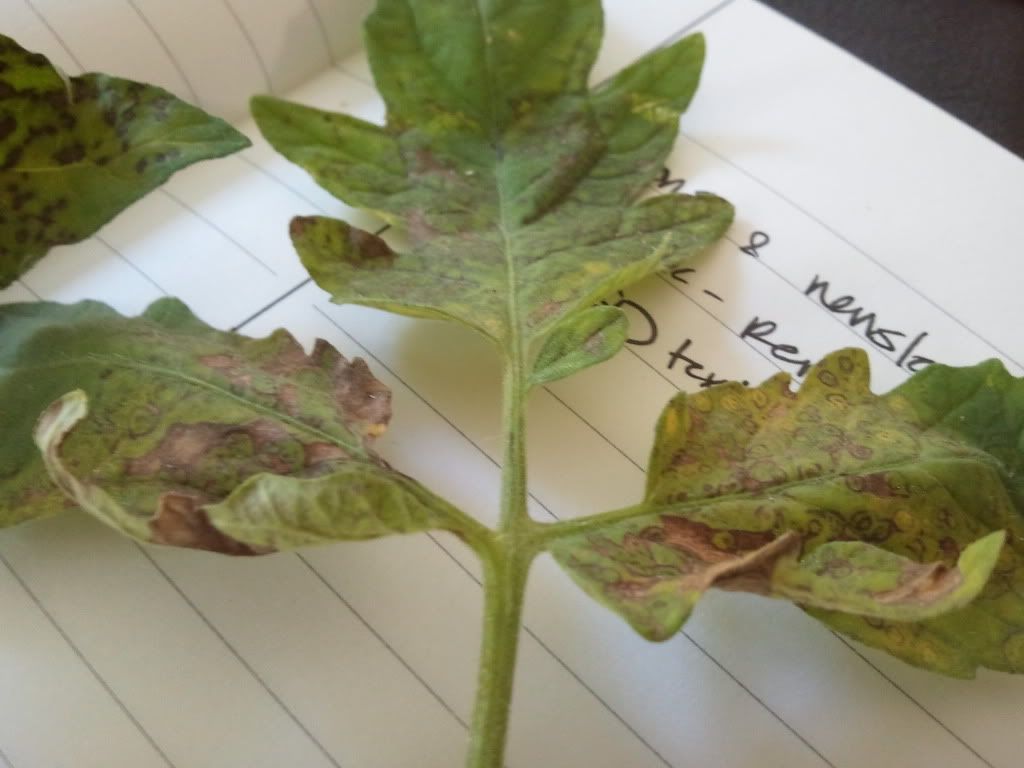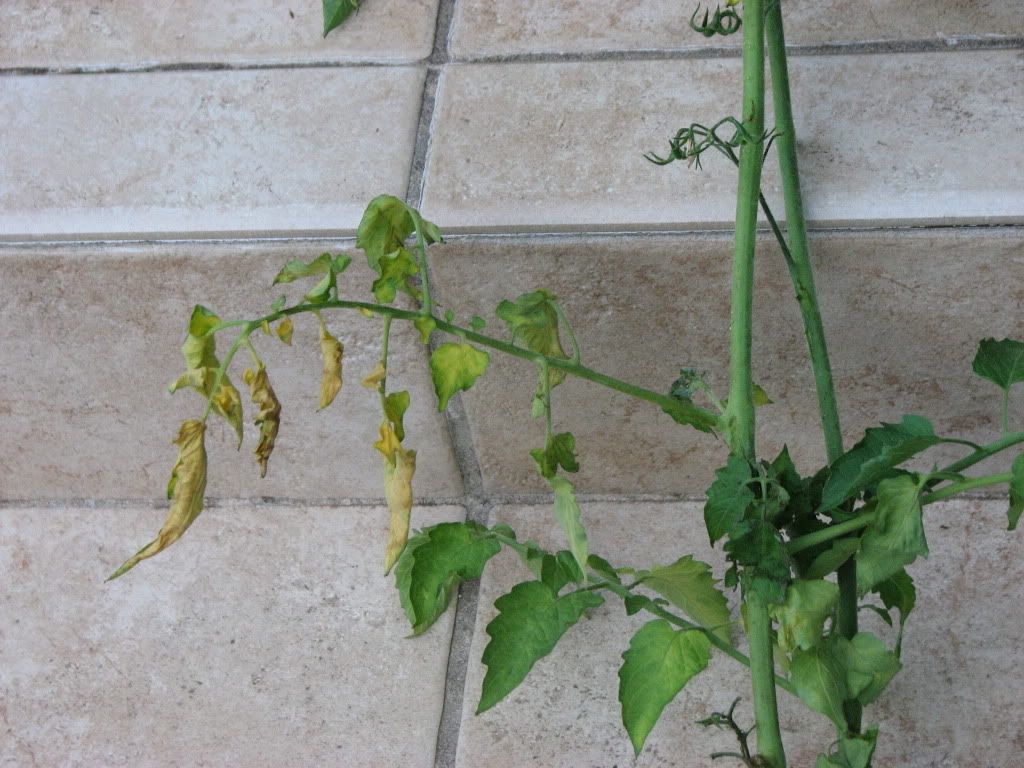How to Identify Fusarium Wilt and Septoria Leaf Spot in Tomatoes
I felt silly displaying a potted ‘Tumbling Tom’ tomato for the Urban Farm Tour since we already had 80 tomato plants in the ground but last week it paid us back with extra early ripe cherries. Now the garden is producing handfuls of medium-sized varieties, leading up to the bumper crop we’ll be able to sell to the public.
I’m getting a lot of disease questions from area gardeners regarding Septoria leaf spot (Septoria lycopersici) and Fusarium wilt (Fusarium oxysporum). Both of these diseases are likely already in your garden soil (or old plant debris) but can also be carried by wind, rain, insects, weeds, and infected seed.
The bad news about Septoria leaf spot in this area is that I almost never see a tomato growing in May that doesn’t have it on the lower leaves. The good news is that it prefers to grow when temperatures are 59 °F – 80 °F.
This means you can pick infected leaves and wait on the hotter weather to set in and discourage it. If you planted your tomatoes with fertile soil in full sun and kept them free of water stress they’re unlikely to die from Septoria leaf spot.

Photo Caption: I think of Septoria leaf spot as the "cartoon eyeballs" of fungal diseases. It starts out looking like little circles with black outlines. As the circles mature, a sand-grain sized black spot (the fruiting body of the fungus) appears in its center. When the disease advances, it looks more like the leaf in this photo. Photo Credit: BitTyrant (Twitter)
My method of dealing with Septoria leaf spot is to fertilize at planting time and make sure conditions are ideal for rapid growth. I also mulch to discourage spores from splashing onto the lower leaves, where the disease first appears. Septoria leaf spot can overwinter on old plant debris and on certain weeds that are also in the nightshade family.
When infected leaves appear I remove them and dispose of them in the garbage, not the compost pile. It usually disappears by late June to early July (though it can come back when the weather cools back off on the fall).

Photo Caption: Fusarium (and Verticillium) wilt shows up as a yellowing of the lower leaves, often on one side of the stem. Cross-sections of the stem will show brown spots in the vascular system of the plant. As the disease progresses, the upper leaves of the plant will appear wilted even when the soil around the roots is moist.
The downside of the warmer weather is that it creates the perfect conditions for Fusarium wilt. There is another disease called Verticillium wilt, with very similar symptoms. This link compares the two. They can also affect eggplants and Irish potatoes.
Clemson Extension Service tells me that both diseases are already present in the soil throughout most of upstate South Carolina and that the best solution for heavily infested soil is to plant tomato varieties that are resistant. When you order tomatoes and seeds, look in the catalog or plant tag description for an “F” to indicate Fusarium wilt resistance and a “V” for Verticillium wilt.

Photo Caption: These photos are of a tomato we removed from the garden last year when it became sick with Fusarium wilt. The variety in this photo is a 'Beam's Yellow Pear' tomato. This year I tried to grow it again in a different garden and it still came down with the same disease -- it is not very resistant.
Every year I have good luck growing heirlooms that are not rated for disease resistance. The trick is just giving them a chance — heirlooms can be vigorous in some areas of the world and weak in others. I usually grow a variety at least 2 years before I reach a verdict on its performance. Sometimes an individual plant has problems but it isn’t a fault in the variety’s genetics. However, if I document that a tomato variety gets sick 2 or more years, I stop growing it. After several years of trials, three tomato varieties that I am unlikely to grow again include ‘Beam’s Yellow Pear’, ‘Roma’, and ‘Green Sausage.’

Photo Caption: Sick leaves can be removed from more resistant plants but tomatoes with severe infections of Fusarium wilt should be entirely removed from the garden to prevent the spores from developing. Increased spores will remain in the soil and infect future crops.
Fusarium wilt thrives in hot weather with moist soil — which perfectly describes late spring in our area. Prevention is difficult but I recently learned that a soil pH of 6.5 – 7 will discourage the spores from growing. Next winter I plan to get soil tests performed so that I can adjust our pH with pelletized limestone.
If your tomatoes look sick and their symptoms don’t match Septoria leaf spot or Fusarium wilt, try this link from Clemson Cooperative Extension listing the tomato problems in our area.
9 thoughts on “How to Identify Fusarium Wilt and Septoria Leaf Spot in Tomatoes”
Comments are closed.


Curbstone Valley Farm - June 23, 2011 12:50 pm
I agree, any heirloom should be tried, even those that others in other areas may have had trouble with. For us, Beam’s Yellow Pear is one of our absolute best performers, year after year. Illini Star, which I know has been successful in gardens elsewhere, what a total disaster for us. It really is about finding the best tomatoes that can survive the challenges of your own garden, and being willing to give them a second chance. We had some perform poorly last year that we’re trying again, as last summer for us was the coldest in 40+ years! Hope we both have a fabulous tomato harvest this season though!
Curbstone Valley Farm´s last blog post ..Hive Health: Varroa Monitoring
Sustainahillbilly
Twitter: appalachianfeet
- June 23, 2011 1:11 pm
I’m glad to know ‘Beam’s Yellow Pear’ is an easy tomato in other areas. I was beginning to wonder why it was so popular, but then the US southeast has a very specific climate.
Sustainahillbilly´s last blog post ..How to Identify Fusarium Wilt and Septoria Leaf Spot in Tomatoes
Janet, The Queen of Seaford - June 23, 2011 9:09 pm
Great information Eliza. We are starting to harvest the one plant we have on the deck, the cherries were planted later– will have to wait a little while for them. Upstate Locally Grown has some great ‘maters that are Heirlooms for sale. Enjoying summer’s bounty.
Janet, The Queen of Seaford´s last blog post ..If It Is June, It Must Be Festival of Flowers
Cathy - June 24, 2011 9:48 pm
Great information — thanks so much for taking the time to give a detailed explanation with photos. I have a feeling both of these nasties have been attacking my tomatoes for the past couple of years. I appreciate the guidance in dealing with them.
Sheila - June 25, 2011 8:08 am
Thanks for a very helpful post. I was wondering if some of my perennials had verticillium or fusarium wilt. Also, now I know what to look for on my tomato plants. They look great now – the problem is reading articles about tomatoes makes me think they’re about to get sick with a terrible disease any minute!
Greggo - June 25, 2011 10:41 am
Nice info to know.
Greggo´s last blog post ..Wordless/Wildflower Wednesday-Pollinators Week
Cat - July 6, 2011 11:59 pm
No tomatoes for me this year and I can’t say I’m sorry for the decision with the drought we’re experiencing! But this is great information for future use. I enjoyed looking through your posts…I can just imagine your kitchen filled with so many chickens! Hope you’re well and enjoying your summer gardening!
Pingback: How to Prevent Fusarium Wilt on Tomatoes | Appalachian Feet
Pingback: Tomato Diseases Pictures Fusarium Wilt